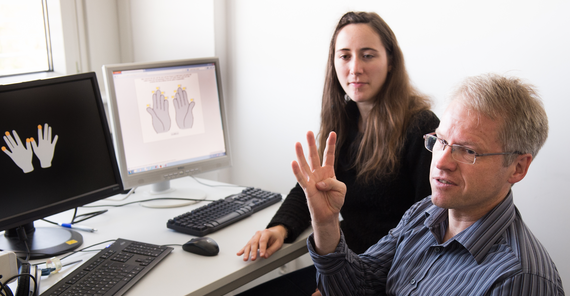Is our brain a computer? A calculating machine? A processor of information with memory capacity problems? For a long time neuroscientists thought so. New theories say that knowledge is always connected with sensomotor perception and that the mind cannot be examined isolated from the body. Martin Fischer, Professor for Cognitive Science at the University of Potsdam, also advocates the “embodied cognition” approach. Together with the “Potsdam Embodied Cognition Group” he examines the significance of finger counting for our understanding of numbers.
Children all over the world count with their fingers. Many also use their hands when they are learning to add, at least in the number range up to ten, after which it gets more difficult. Even after having learnt mental arithmetic, numbers and fingers will remain “linked” throughout their lives. For instance when asked to count the syllables of a sentence, adults will say the words either in their thoughts or aloud and use their fingers to count. “The brain cannot say one thing while counting another,” Fischer explains. “That is why it outsources this task.” Cognitive scientists call this the “externalization of memory”.
As part of the “Potsdam Embodied Cognition Group” he founded, Fischer’s current project examines the significance of finger counting for the representation of numbers in the brain. So far they have tested only adults. PhD student Elena Sixtus demonstrates a method in the laboratory for examining the relation between the fingers’ discrimination capacity and number processing, in which test subjects hold two handles that alternately stimulate their fingertips. While the subject says the number corresponding to the finger, the researcher can monitor the speed and precision of the information on a connected computer. Marks on the stimulated fingers appear on the monitor that displays two hands with the fingers spread.
They also plan to test children. Reliable knowledge about the representation of numbers in the brain, their sensual and spatial perception can help to diagnose and treat dyslexia at an early stage, improve math textbooks and develop educational computers. “When children move the cursor with a mouse on the computer, they have to coordinate between their hand and the screen. This requires comprehensive mental performance,” says Fischer. “Purely motor-operated tablets do not require this spatial transformation, which is why we learn more easily with them,” the cognitive scientist says.
Although the present study is fundamental research, Fischer constantly has future applications in mind. He has been working with the Potsdam Zentrum zur Therapie
der Rechenschwäche, a center for dyscalculia and arithmasthenia, to help people suffering from these disorders. Not least, findings about “embodied cognition”
can help in neurological rehabilitation. The influence of thinking by spatial perception becomes evident when limited by disease or injury. Fischer reports on patients who suffer from so-called hemispatial neglect after a stroke. “They ignore the left side of space. When they draw a clock you can only see the numbers 12 to 6. When asked to divide a line in the middle, they put the slash on the right third …”
How are numbers represented in our brains? Fischer thinks that people develop a mental number line. Addition moves from left to right on this hypothetic line, subtraction from right to left. Small numbers are on the left, big number on the right. A simple experiment1 impressively proves this. Subjects were asked to turn their heads according to the clicks of a metronome and say numbers between one
and thirty. While facing left, they said relatively small numbers, whereas facing right they tended to say larger numbers. Whether on a ruler, timeline or keyboard, numbers increase from left to right. “When we count with our fingers we prefer starting with the left thumb, at least we Europeans,” Fischer adds and refers to cultural differences. “North Americans also begin on the left but mostly with the index finger. While we stretch our fingers from the fist, Asians begin with their open hand and then bend their fingers one by one. Chinese people can even count up to ten on one hand by crossing two fingers.”
That the number line in our head is culturally influenced is most clearly demonstrated by the counting method in Arab countries: “Just as they read and write from right to left, they also start counting on the right, very often with their little finger,” says Fischer. If and how these different techniques influence the understanding of numbers and arithmetic capacities still has to be examined. The Potsdam cognitive scientists are collecting data worldwide with the help of an Internet-based finger questionnaire. More than 3,000 people have already taken this 5-minute test. “We would like more participants from Asia. Data from African and Latin American countries is still quite sparse, too,” Fischer says, pitching the short experiment. To take part and count with your fingers for the sake of cognitive science, visit www.counting.cognitive-psychology.eu.
The Scientist
Prof. Martin Fischer studied psychology at the Technical University of Aachen and then researched motor control and eye movement during reading at the University of Massachusetts – Amherst. After completing his PhD he worked at the Ludwig-Maximilians University in Munich and the University of Dundee in Scotland. Since 2011 he has been Professor of Cognitive Science at the University of Potsdam.
Contact
Universität Potsdam
Department Psychologie
Karl-Liebknecht-Str. 24–25
14476 Potsdam OT Golm
martinfuuni-potsdampde
www.uni-potsdam.de/pecog
The Project
Manumerical cognition: Assessing the contributions of ordinal, cardinal and spatial components of finger counting to adult numerical cognition Funded by: German Research Foundation (DFG)
Text: Antje Horn-Conrad, Online-Editing: Agnes Bressa, Translation: Susanne Voigt

